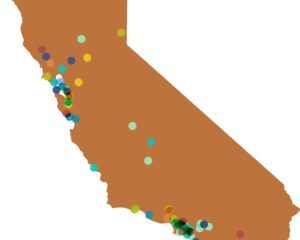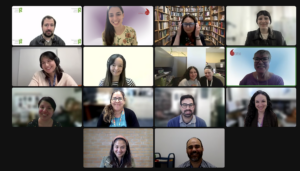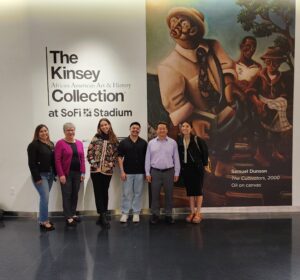Above: A sampling of records produced in California by the Mexican American record labels Coast, Imperial, FAMA, Azteca, Globe, and Colonial. Courtesy of the Arhoolie Frontera Collection.
In celebration of Hispanic Heritage Month starting September 15, we are revisiting Rumbo a California, an exhibit about Mexican music in the Golden State, which first launched in 2022 with support from a California Humanities’ Humanities for All Project Grant. Featuring playlists of Mexican and Mexican American music available digitally and ambiently, LP covers, photographs, posters, cinema lobby cards, self-guided audio, and bilingual transcriptions of topical corridos addressing the themes of immigration, the project celebrates California as symbol and a destination, pachuco culture, the United Farm Workers Movement, the Chicano Civil Rights Movement, cultural identity, love, death and more.

Last month, we checked in with Rumbo a California’s lead writer and curator, Juan Antonio Cuéllar Anguiano, who also serves as the curator of the Frontera Collection of Mexican and Mexican American Recordings for the Arhoolie Foundation, a nonprofit devoted to preserving American roots music. The Frontera Collection’s invaluable repository, which Arhoolie has been preserving in partnership with the UCLA Chicano Studies Research Center and the UCLA Library, contains over 150,000 individual recordings on 78, 45 and 33-rpm discs as well as rare cassettes and open-reel master tapes. It is the world’s largest collection of commercially recorded regional Mexican music and provides the basis for Rumbo a California.
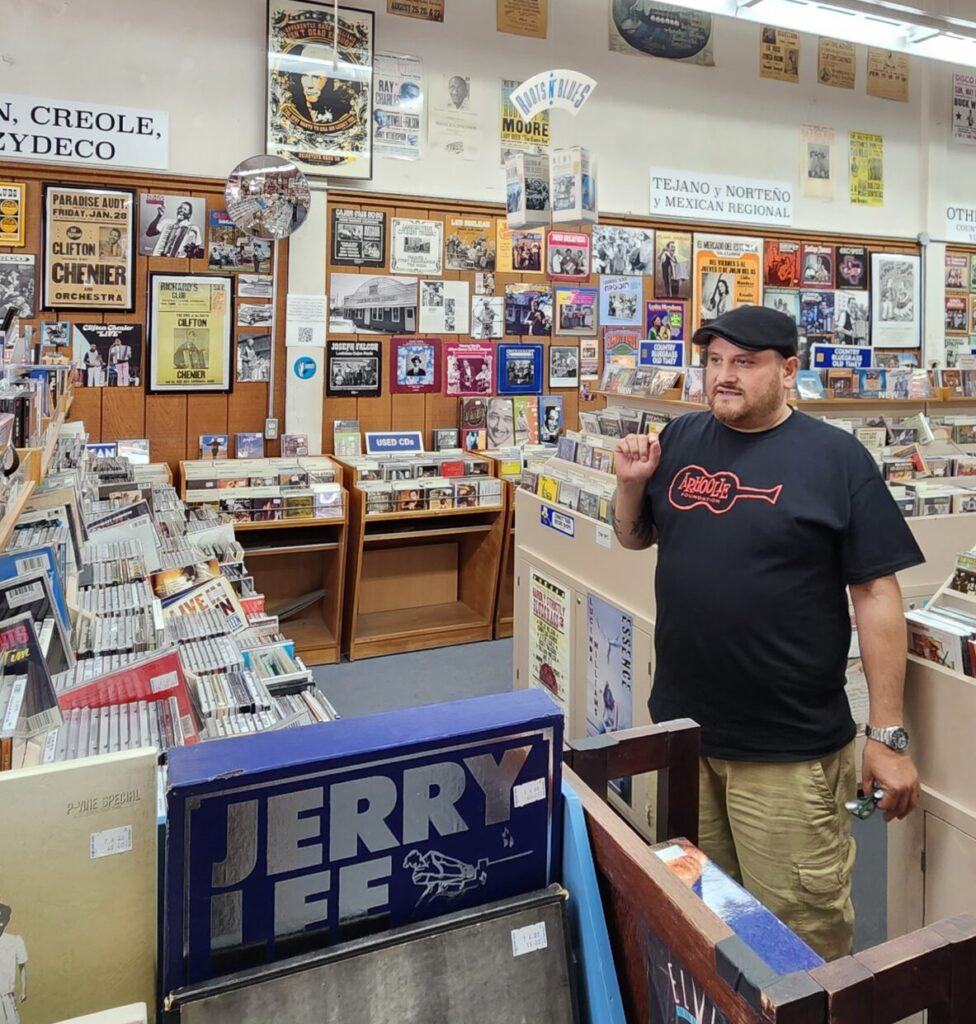
Why did you decide to do this project?
We undertook this project because it granted us the chance to present a small portion of the world’s largest collection of Spanish-language music: The Strachwitz Frontera Collection. Being able to honor these artifacts that originated within the Mexican American community and conveyed the immigrant experience through their own words, while continuing the oral storytelling tradition using song as the medium, was of utmost importance to us. Very little has been documented in comparison to other genres that were recorded in the United States, and much of what is within this collection remains undiscovered by the general public.
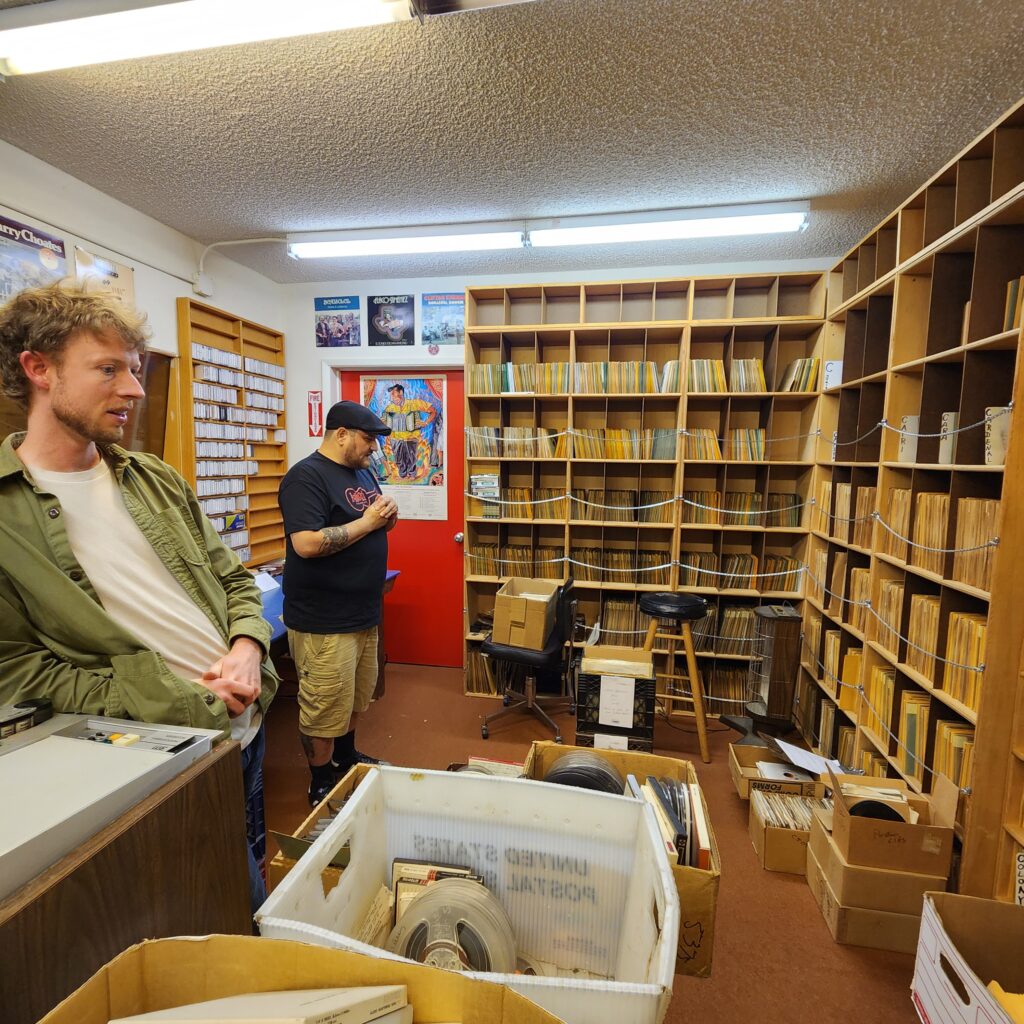
Clark Noone and Juan Antonio Cuellar inside the Frontera Collection’s archive inside the Arhoolie Foundation.
California Humanities photo.
Frontera Collection discs organized by type inside the Arhoolie Foundation’s building in El Cerrito.
California Humanities photo.
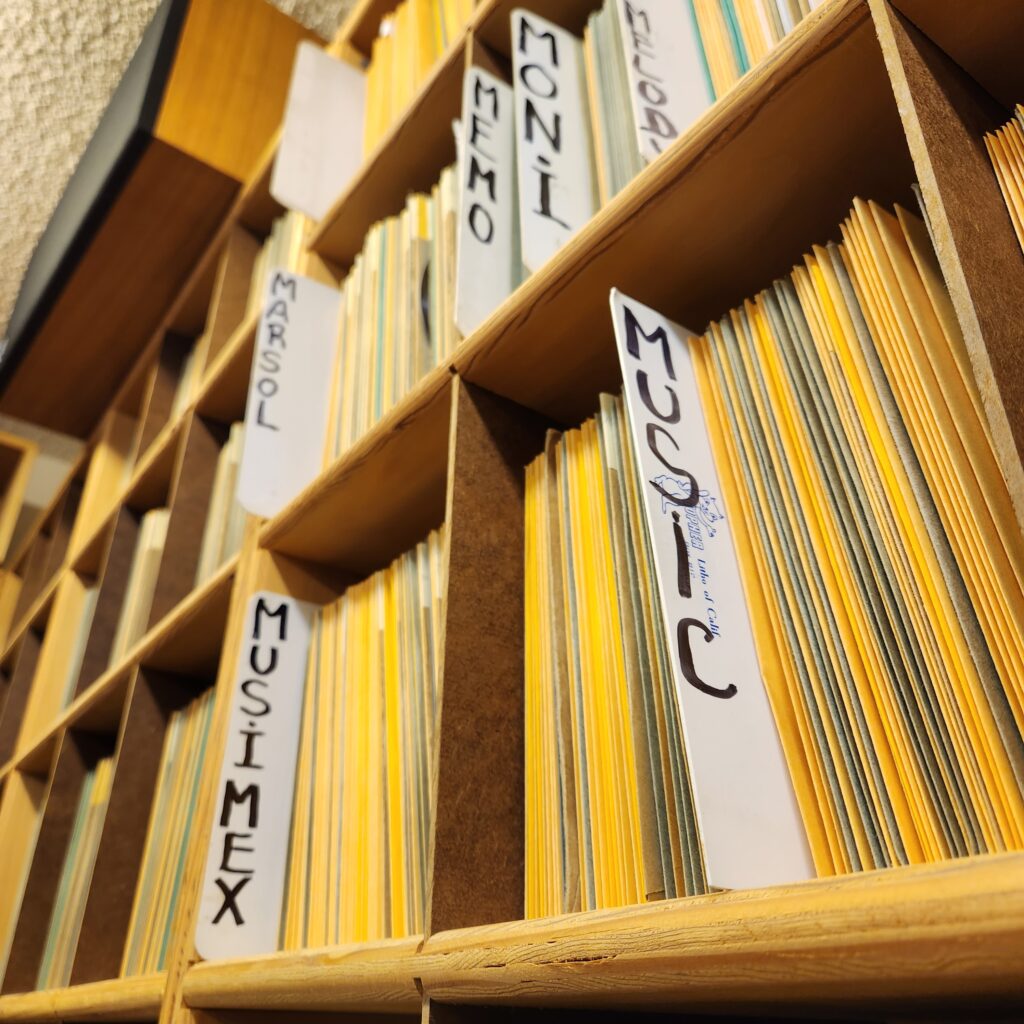
How did you go about selecting content? How did scholars and culture bearers inform your process?
The initial step in the content selection process for Rumbo a California involved identifying relevant, accurate, and meaningful subjects tailored to our target audience. Additionally, we sought to determine which artists, songs, and labels personally resonated with myself as the curator. Given that I had digitized the majority of the music in our collection, I possessed an intimate understanding of the themes archived within it, which mirrored the life, history, and experiences of California’s largest and fastest-growing immigrant community.
Consequently, we established thematic parameters and focused on curating an exhibition that reflected a distinctly Californian experience. It’s worth noting that while numerous challenges and triumphs faced by the Mexican American community were universal, our achievement lay in crafting an exhibition that directly addressed the Mexican American community in California while also possessing a universal appeal that could resonate with individuals from all walks of life.
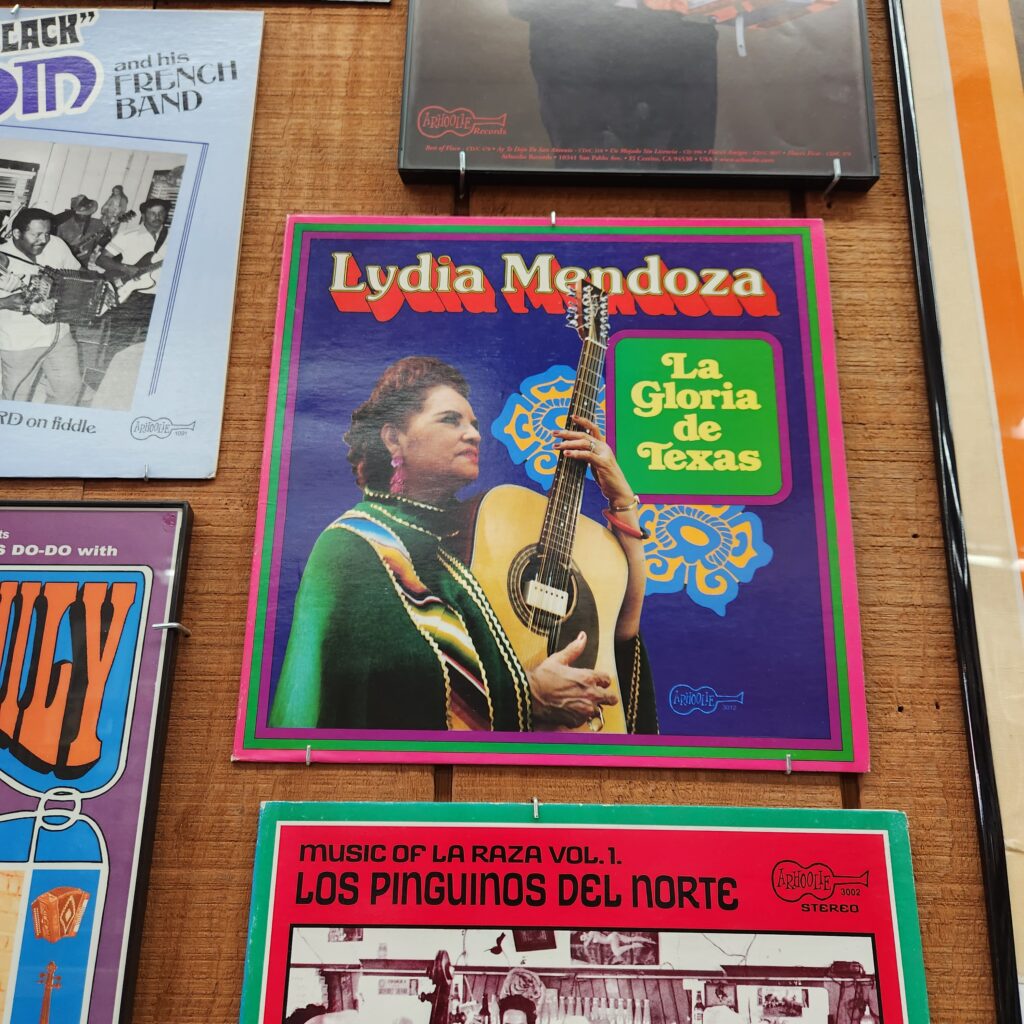
A Lydia Mendoza record cover inside Down Home Records. Mendoza, a well-known Mexican American guitarist and singer of Tejano and traditional Mexican American music, is often referred to as ‘The Mother of Tejano Music.’
California Humanities photo.
The Arhoolie Foundation has many hours of oral history recordings with Mendoza, awaiting digitization and preservation.
California Humanities photo.

Our team included a diverse group of scholars and cultural custodians, who generously shared their expertise and engaged with the highlighted content. Their involvement went beyond mere contribution; they offered invaluable insights into cultural contexts, traditions, and subtleties. Their input played a crucial role in ensuring that the content maintained respect, accuracy, and cultural sensitivity.
As the lead writer and someone born in Mexico, actively engaged in the Mexican American experience in the United States, I was in a unique position to spotlight elements that resonated with me. I also could highlight themes and narratives that mirrored my upbringing in California. This lived experience played a central role in enriching the overall exhibition.
Initially, the Arhoolie Foundation planned Rumbo a California as a traveling exhibit. During the pandemic, you pivoted online. Did you encounter any interesting elements in producing an online exhibit?
The global pandemic affected every aspect of society, including our initial plan to travel with Rumbo a California throughout the state. Transitioning from an in-person exhibition to an online format posed challenges but also expanded its potential global reach exponentially.
Breaking down geographical barriers and enabling people from various parts of the world to access the content was a significant advantage. This was especially valuable for those who had moved away from California to other locations, as they could now remotely enjoy and connect with the exhibition. This shift also provided us with real-time access to analytics, user engagement data, and visitor behavior.
Having this access helped us identify which parts of the exhibition resonated most with the audience. We used this information to curate social media posts that heightened awareness and attracted more traffic to Rumbo. The transition from an in-person to an online format compelled us to enhance our digital storytelling skills. It offered the opportunity for creative storytelling using all our digital assets, extending far beyond just the music.
We incorporated archival photos, downloadable lyric sheets, as well as a meticulously curated continuous musical soundtrack to completely immerse the end user in the presented content.
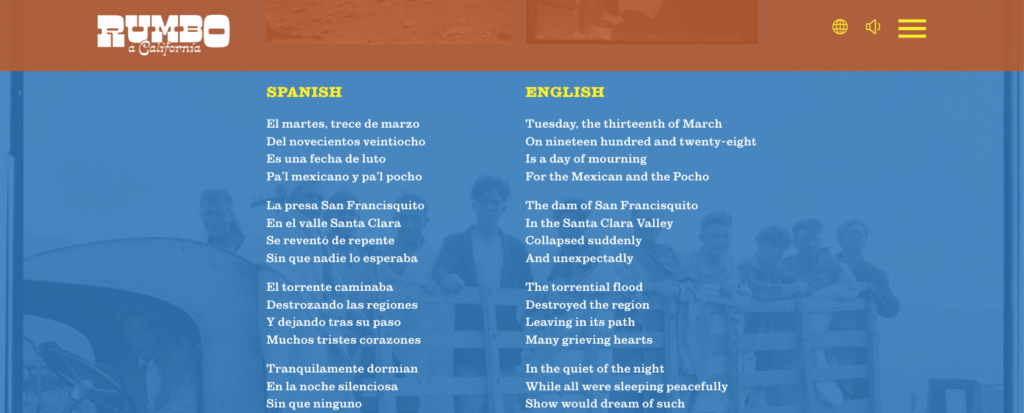
Since its launch in 2022, your exhibit has been viewed by over 15,000 visitors. What feedback have you received – from the public, the music community, scholars, advocates, etc.? Do you have other plans to continue or extend this project?
The feedback has been extremely positive and has created opportunities for ongoing storytelling and collaborations. During the initial promotional phase following the launch, we received contact from numerous organizations interested in promoting the site. These inquiries included requests for interviews, and guest appearances on radio shows to feature music from the exhibition and provide direct context from the exhibition itself.
One interviewer from the popular Radio Bilingue show “Linea Abierta” even went so far as to mention that the exhibit took her back to her childhood. The sights and sounds that formed the backdrop of her youth were revitalized, a digital resurrection that only came to life for her upon discovering Rumbo a California. Our social media promotion of the site also facilitated dialogues with artists and community members who shared further insights about certain themes presented in the exhibit.
We have been contacted by professors in academia and other archives who were equally interested in and impressed by the themes we highlighted in the exhibition. This presents a wonderful opportunity to expand the site and invite others to contribute to this ongoing cultural exploration.
What advice do you have for other public humanities practitioners?
There is so much to share based on our experience with Rumbo a California that it would be difficult to touch upon all of it. The key lesson we have drawn, and one I cannot emphasize enough, is the significance of comprehending the interests, needs, and expectations of your target audience. Customizing your content and approach to effectively engage and resonate with them is paramount.
A collaborative approach is imperative. Extend invitations for dialogue and create a platform for scholars, artists, community members, and organizations to contribute their diverse expertise and viewpoints to your projects. Collaboration has the potential to enrich content and foster a sense of community engagement.
Strive to present scholarly content in an accessible manner without compromising on depth. Utilize clear language and provide context to make intricate concepts understandable to a wider audience. Often, engagement falters due to the use of technical jargon that isn’t reflective of the communities you aim to engage.
“Maintain a stance of curiosity and keep yourself updated.”
Juan Antonio Cuéllar
Lastly, maintain a stance of curiosity and keep yourself updated. Continue learning and stay attuned to emerging trends, research, and novel methods to engage with cultural subjects. Staying current ensures that you remain well-equipped to navigate the evolving landscape of cultural exploration.
Visit the Rumbo a California online exhibition.
Listen to selections from the Frontera Collection on their YouTube channel.
Listen to recent recordings of Raza, Accordions, & Rock, a monthly show hosted on Dublab to spotlight the many untold stories hidden within the grooves of the Strachwitz Frontera Collection. Hosted by Juan Antonio Cuéllar.


